Analyzing Parametric Estimation in Non-Engineering Project Scenarios
VerifiedAdded on 2023/06/08
|6
|1251
|123
Report
AI Summary
This report explores the application of parametric estimation in non-engineering projects, drawing from Terry Cooke-Davies' "Aspects of Complexity." It discusses how parametric estimation, traditionally used in engineering to analyze time and cost, can be effectively applied to non-engineering fields. The report outlines various approaches within the parametric model, including addressing data limitations, calculating Return on Investment (ROI), and normalizing data for manufacturing rates and unit capacity. It justifies the use of parametric estimation in non-engineering projects by highlighting the necessity of cost and time evaluation regardless of the project's technical complexity. The report also addresses the challenges and limitations of using mature technologies and concludes that parametric estimation aids in achieving project requirements in non-engineering contexts, making it a valuable tool for project managers. Desklib provides access to similar solved assignments and resources for students.
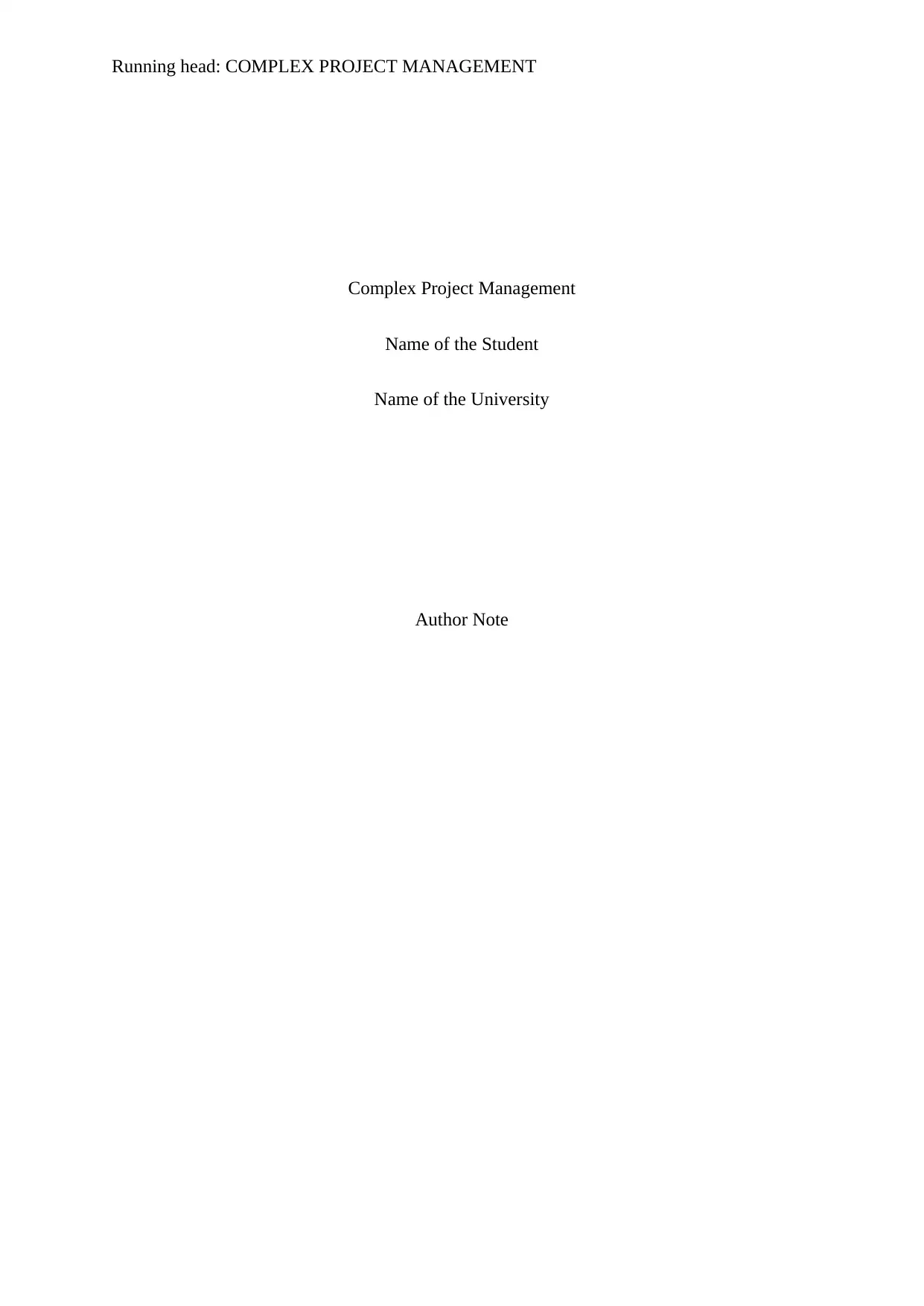
Running head: COMPLEX PROJECT MANAGEMENT
Complex Project Management
Name of the Student
Name of the University
Author Note
Complex Project Management
Name of the Student
Name of the University
Author Note
Paraphrase This Document
Need a fresh take? Get an instant paraphrase of this document with our AI Paraphraser
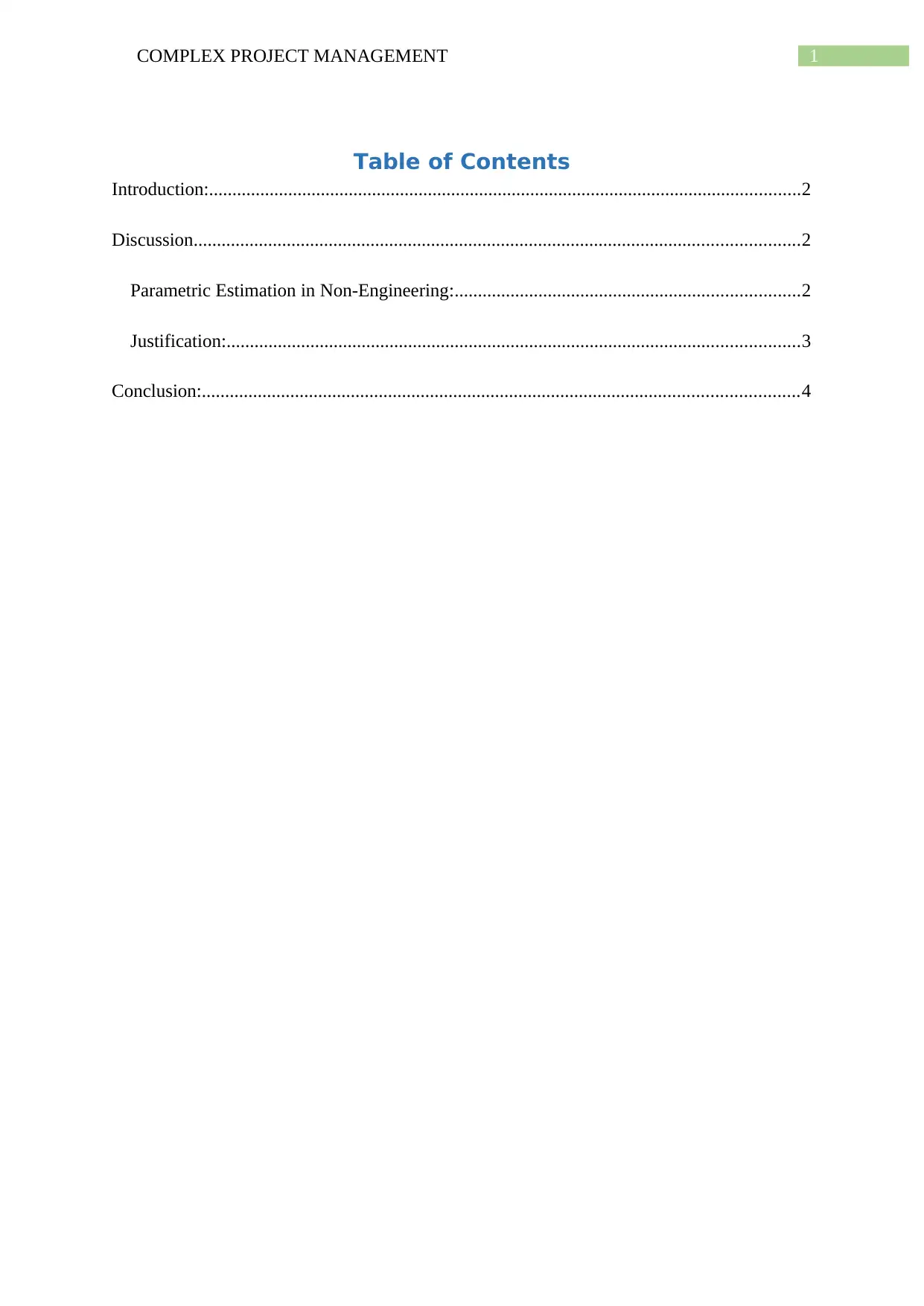
1COMPLEX PROJECT MANAGEMENT
Table of Contents
Introduction:...............................................................................................................................2
Discussion..................................................................................................................................2
Parametric Estimation in Non-Engineering:..........................................................................2
Justification:...........................................................................................................................3
Conclusion:................................................................................................................................4
Table of Contents
Introduction:...............................................................................................................................2
Discussion..................................................................................................................................2
Parametric Estimation in Non-Engineering:..........................................................................2
Justification:...........................................................................................................................3
Conclusion:................................................................................................................................4
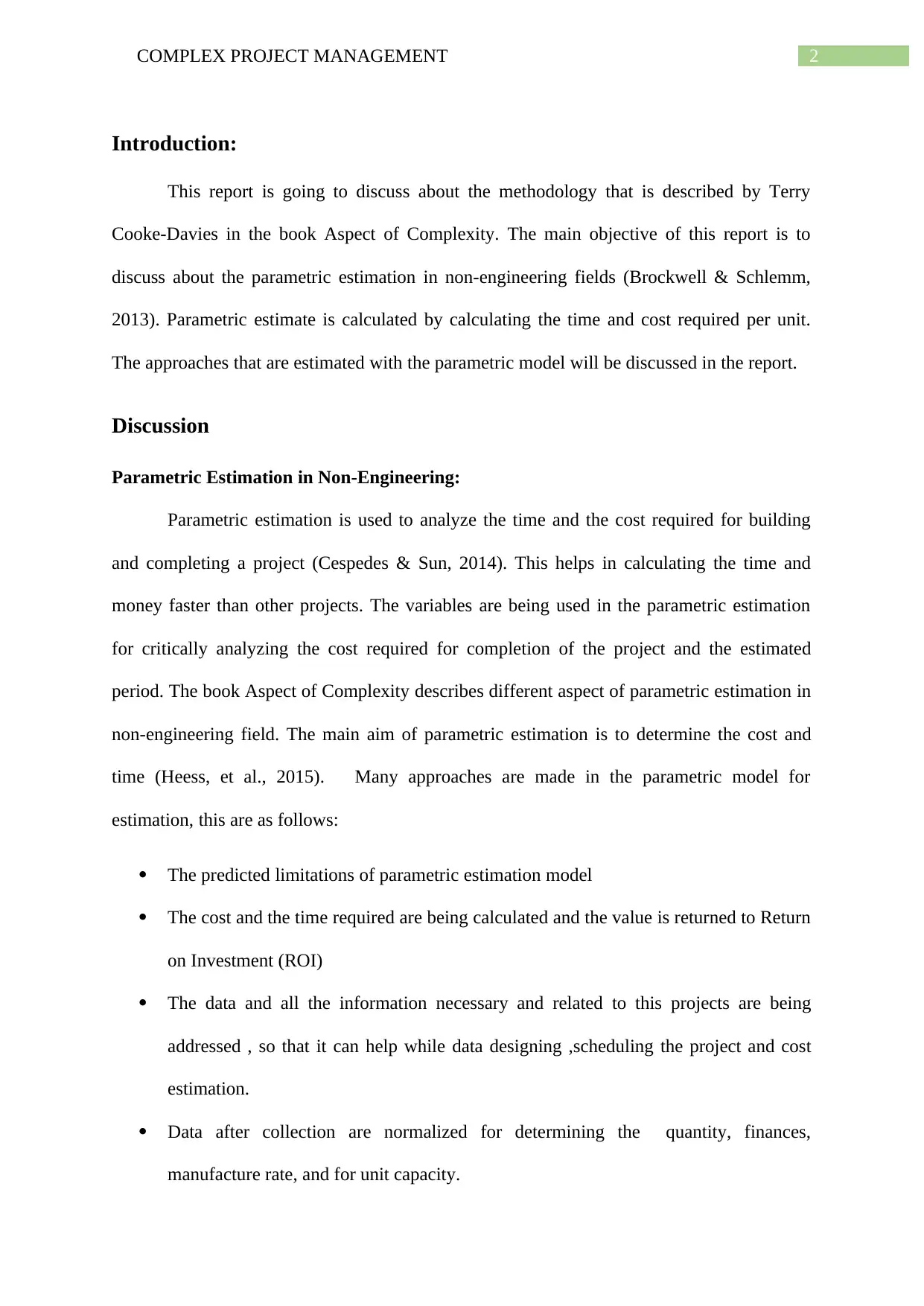
2COMPLEX PROJECT MANAGEMENT
Introduction:
This report is going to discuss about the methodology that is described by Terry
Cooke-Davies in the book Aspect of Complexity. The main objective of this report is to
discuss about the parametric estimation in non-engineering fields (Brockwell & Schlemm,
2013). Parametric estimate is calculated by calculating the time and cost required per unit.
The approaches that are estimated with the parametric model will be discussed in the report.
Discussion
Parametric Estimation in Non-Engineering:
Parametric estimation is used to analyze the time and the cost required for building
and completing a project (Cespedes & Sun, 2014). This helps in calculating the time and
money faster than other projects. The variables are being used in the parametric estimation
for critically analyzing the cost required for completion of the project and the estimated
period. The book Aspect of Complexity describes different aspect of parametric estimation in
non-engineering field. The main aim of parametric estimation is to determine the cost and
time (Heess, et al., 2015). Many approaches are made in the parametric model for
estimation, this are as follows:
The predicted limitations of parametric estimation model
The cost and the time required are being calculated and the value is returned to Return
on Investment (ROI)
The data and all the information necessary and related to this projects are being
addressed , so that it can help while data designing ,scheduling the project and cost
estimation.
Data after collection are normalized for determining the quantity, finances,
manufacture rate, and for unit capacity.
Introduction:
This report is going to discuss about the methodology that is described by Terry
Cooke-Davies in the book Aspect of Complexity. The main objective of this report is to
discuss about the parametric estimation in non-engineering fields (Brockwell & Schlemm,
2013). Parametric estimate is calculated by calculating the time and cost required per unit.
The approaches that are estimated with the parametric model will be discussed in the report.
Discussion
Parametric Estimation in Non-Engineering:
Parametric estimation is used to analyze the time and the cost required for building
and completing a project (Cespedes & Sun, 2014). This helps in calculating the time and
money faster than other projects. The variables are being used in the parametric estimation
for critically analyzing the cost required for completion of the project and the estimated
period. The book Aspect of Complexity describes different aspect of parametric estimation in
non-engineering field. The main aim of parametric estimation is to determine the cost and
time (Heess, et al., 2015). Many approaches are made in the parametric model for
estimation, this are as follows:
The predicted limitations of parametric estimation model
The cost and the time required are being calculated and the value is returned to Return
on Investment (ROI)
The data and all the information necessary and related to this projects are being
addressed , so that it can help while data designing ,scheduling the project and cost
estimation.
Data after collection are normalized for determining the quantity, finances,
manufacture rate, and for unit capacity.
⊘ This is a preview!⊘
Do you want full access?
Subscribe today to unlock all pages.

Trusted by 1+ million students worldwide
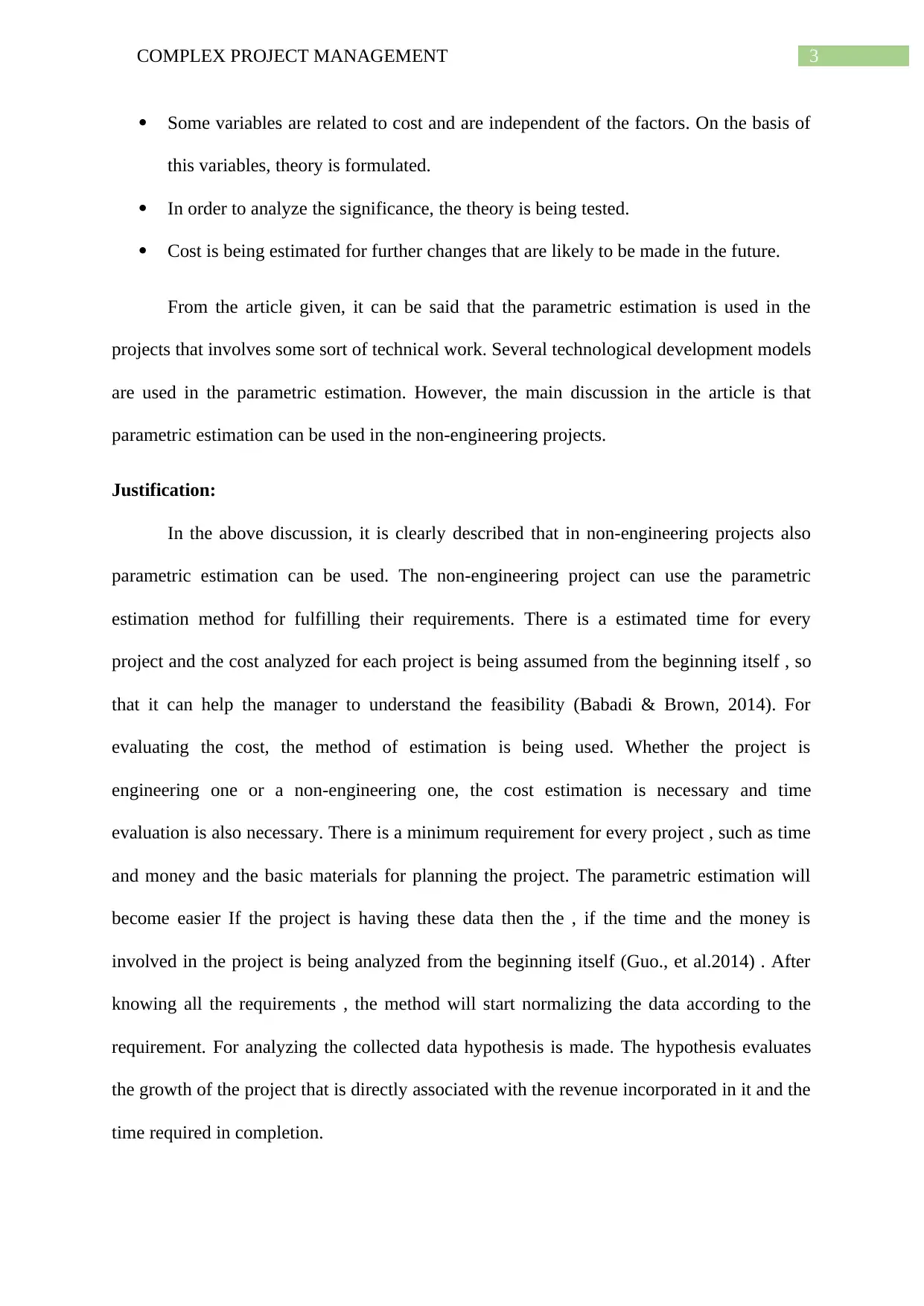
3COMPLEX PROJECT MANAGEMENT
Some variables are related to cost and are independent of the factors. On the basis of
this variables, theory is formulated.
In order to analyze the significance, the theory is being tested.
Cost is being estimated for further changes that are likely to be made in the future.
From the article given, it can be said that the parametric estimation is used in the
projects that involves some sort of technical work. Several technological development models
are used in the parametric estimation. However, the main discussion in the article is that
parametric estimation can be used in the non-engineering projects.
Justification:
In the above discussion, it is clearly described that in non-engineering projects also
parametric estimation can be used. The non-engineering project can use the parametric
estimation method for fulfilling their requirements. There is a estimated time for every
project and the cost analyzed for each project is being assumed from the beginning itself , so
that it can help the manager to understand the feasibility (Babadi & Brown, 2014). For
evaluating the cost, the method of estimation is being used. Whether the project is
engineering one or a non-engineering one, the cost estimation is necessary and time
evaluation is also necessary. There is a minimum requirement for every project , such as time
and money and the basic materials for planning the project. The parametric estimation will
become easier If the project is having these data then the , if the time and the money is
involved in the project is being analyzed from the beginning itself (Guo., et al.2014) . After
knowing all the requirements , the method will start normalizing the data according to the
requirement. For analyzing the collected data hypothesis is made. The hypothesis evaluates
the growth of the project that is directly associated with the revenue incorporated in it and the
time required in completion.
Some variables are related to cost and are independent of the factors. On the basis of
this variables, theory is formulated.
In order to analyze the significance, the theory is being tested.
Cost is being estimated for further changes that are likely to be made in the future.
From the article given, it can be said that the parametric estimation is used in the
projects that involves some sort of technical work. Several technological development models
are used in the parametric estimation. However, the main discussion in the article is that
parametric estimation can be used in the non-engineering projects.
Justification:
In the above discussion, it is clearly described that in non-engineering projects also
parametric estimation can be used. The non-engineering project can use the parametric
estimation method for fulfilling their requirements. There is a estimated time for every
project and the cost analyzed for each project is being assumed from the beginning itself , so
that it can help the manager to understand the feasibility (Babadi & Brown, 2014). For
evaluating the cost, the method of estimation is being used. Whether the project is
engineering one or a non-engineering one, the cost estimation is necessary and time
evaluation is also necessary. There is a minimum requirement for every project , such as time
and money and the basic materials for planning the project. The parametric estimation will
become easier If the project is having these data then the , if the time and the money is
involved in the project is being analyzed from the beginning itself (Guo., et al.2014) . After
knowing all the requirements , the method will start normalizing the data according to the
requirement. For analyzing the collected data hypothesis is made. The hypothesis evaluates
the growth of the project that is directly associated with the revenue incorporated in it and the
time required in completion.
Paraphrase This Document
Need a fresh take? Get an instant paraphrase of this document with our AI Paraphraser
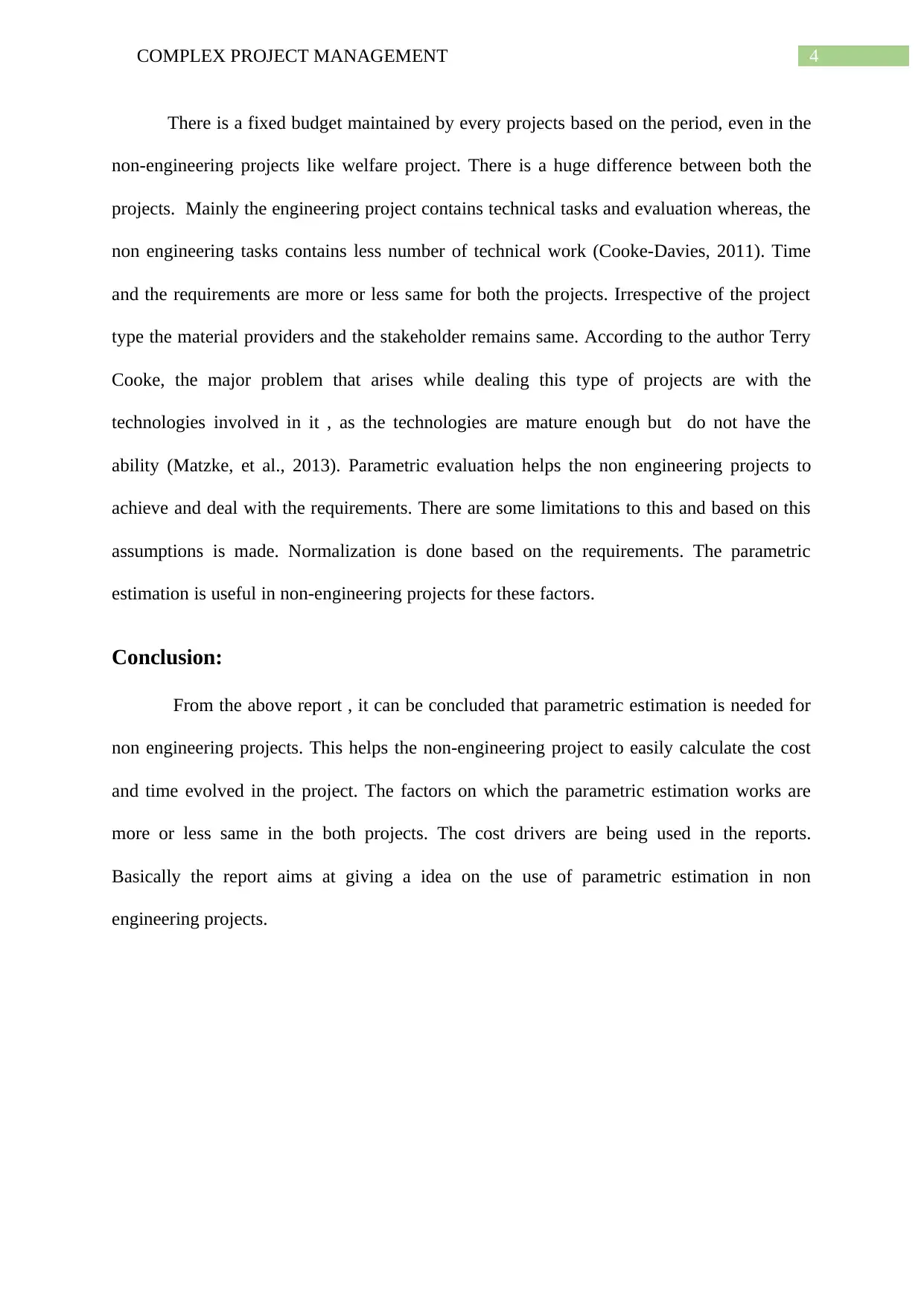
4COMPLEX PROJECT MANAGEMENT
There is a fixed budget maintained by every projects based on the period, even in the
non-engineering projects like welfare project. There is a huge difference between both the
projects. Mainly the engineering project contains technical tasks and evaluation whereas, the
non engineering tasks contains less number of technical work (Cooke-Davies, 2011). Time
and the requirements are more or less same for both the projects. Irrespective of the project
type the material providers and the stakeholder remains same. According to the author Terry
Cooke, the major problem that arises while dealing this type of projects are with the
technologies involved in it , as the technologies are mature enough but do not have the
ability (Matzke, et al., 2013). Parametric evaluation helps the non engineering projects to
achieve and deal with the requirements. There are some limitations to this and based on this
assumptions is made. Normalization is done based on the requirements. The parametric
estimation is useful in non-engineering projects for these factors.
Conclusion:
From the above report , it can be concluded that parametric estimation is needed for
non engineering projects. This helps the non-engineering project to easily calculate the cost
and time evolved in the project. The factors on which the parametric estimation works are
more or less same in the both projects. The cost drivers are being used in the reports.
Basically the report aims at giving a idea on the use of parametric estimation in non
engineering projects.
There is a fixed budget maintained by every projects based on the period, even in the
non-engineering projects like welfare project. There is a huge difference between both the
projects. Mainly the engineering project contains technical tasks and evaluation whereas, the
non engineering tasks contains less number of technical work (Cooke-Davies, 2011). Time
and the requirements are more or less same for both the projects. Irrespective of the project
type the material providers and the stakeholder remains same. According to the author Terry
Cooke, the major problem that arises while dealing this type of projects are with the
technologies involved in it , as the technologies are mature enough but do not have the
ability (Matzke, et al., 2013). Parametric evaluation helps the non engineering projects to
achieve and deal with the requirements. There are some limitations to this and based on this
assumptions is made. Normalization is done based on the requirements. The parametric
estimation is useful in non-engineering projects for these factors.
Conclusion:
From the above report , it can be concluded that parametric estimation is needed for
non engineering projects. This helps the non-engineering project to easily calculate the cost
and time evolved in the project. The factors on which the parametric estimation works are
more or less same in the both projects. The cost drivers are being used in the reports.
Basically the report aims at giving a idea on the use of parametric estimation in non
engineering projects.
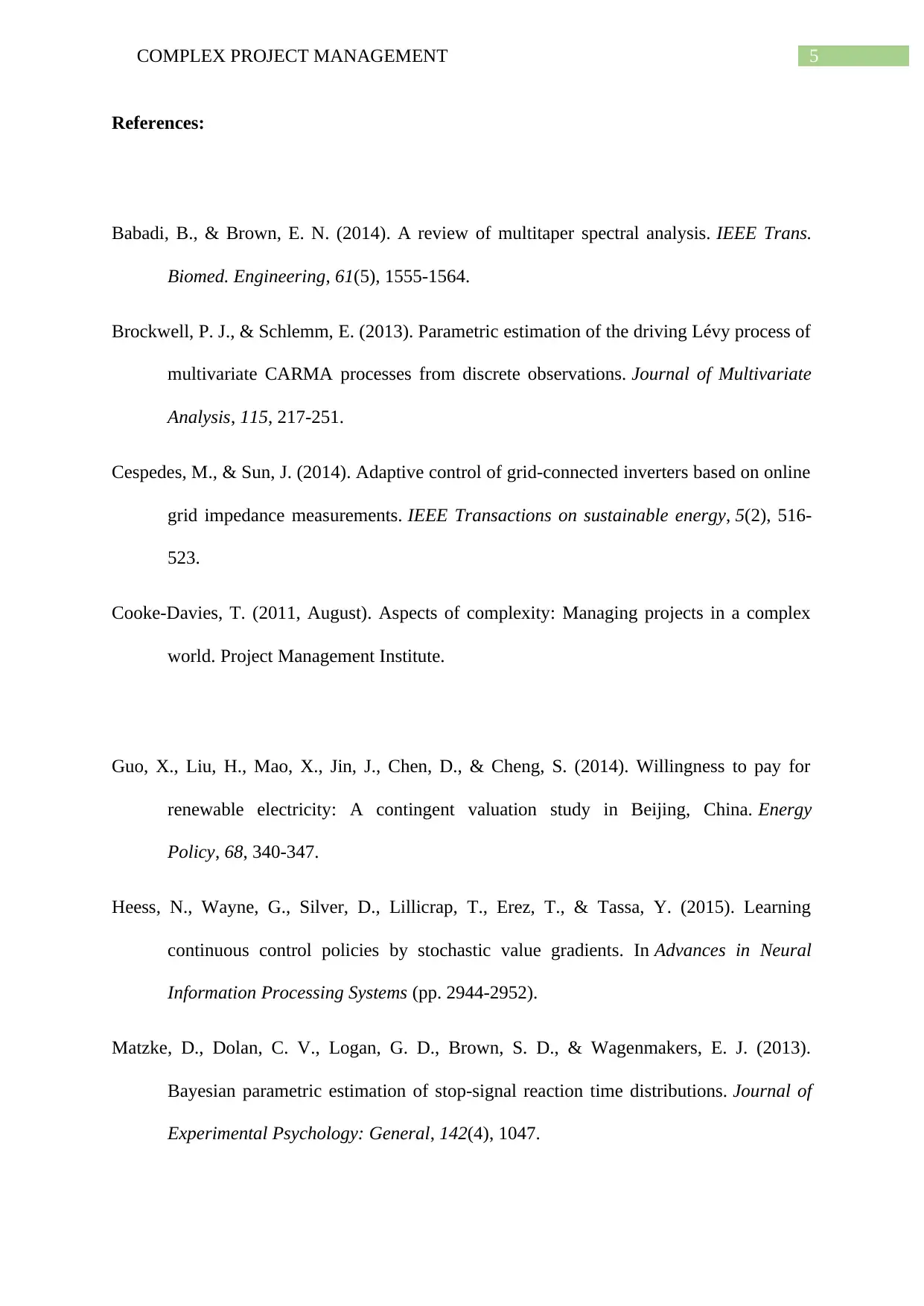
5COMPLEX PROJECT MANAGEMENT
References:
Babadi, B., & Brown, E. N. (2014). A review of multitaper spectral analysis. IEEE Trans.
Biomed. Engineering, 61(5), 1555-1564.
Brockwell, P. J., & Schlemm, E. (2013). Parametric estimation of the driving Lévy process of
multivariate CARMA processes from discrete observations. Journal of Multivariate
Analysis, 115, 217-251.
Cespedes, M., & Sun, J. (2014). Adaptive control of grid-connected inverters based on online
grid impedance measurements. IEEE Transactions on sustainable energy, 5(2), 516-
523.
Cooke-Davies, T. (2011, August). Aspects of complexity: Managing projects in a complex
world. Project Management Institute.
Guo, X., Liu, H., Mao, X., Jin, J., Chen, D., & Cheng, S. (2014). Willingness to pay for
renewable electricity: A contingent valuation study in Beijing, China. Energy
Policy, 68, 340-347.
Heess, N., Wayne, G., Silver, D., Lillicrap, T., Erez, T., & Tassa, Y. (2015). Learning
continuous control policies by stochastic value gradients. In Advances in Neural
Information Processing Systems (pp. 2944-2952).
Matzke, D., Dolan, C. V., Logan, G. D., Brown, S. D., & Wagenmakers, E. J. (2013).
Bayesian parametric estimation of stop-signal reaction time distributions. Journal of
Experimental Psychology: General, 142(4), 1047.
References:
Babadi, B., & Brown, E. N. (2014). A review of multitaper spectral analysis. IEEE Trans.
Biomed. Engineering, 61(5), 1555-1564.
Brockwell, P. J., & Schlemm, E. (2013). Parametric estimation of the driving Lévy process of
multivariate CARMA processes from discrete observations. Journal of Multivariate
Analysis, 115, 217-251.
Cespedes, M., & Sun, J. (2014). Adaptive control of grid-connected inverters based on online
grid impedance measurements. IEEE Transactions on sustainable energy, 5(2), 516-
523.
Cooke-Davies, T. (2011, August). Aspects of complexity: Managing projects in a complex
world. Project Management Institute.
Guo, X., Liu, H., Mao, X., Jin, J., Chen, D., & Cheng, S. (2014). Willingness to pay for
renewable electricity: A contingent valuation study in Beijing, China. Energy
Policy, 68, 340-347.
Heess, N., Wayne, G., Silver, D., Lillicrap, T., Erez, T., & Tassa, Y. (2015). Learning
continuous control policies by stochastic value gradients. In Advances in Neural
Information Processing Systems (pp. 2944-2952).
Matzke, D., Dolan, C. V., Logan, G. D., Brown, S. D., & Wagenmakers, E. J. (2013).
Bayesian parametric estimation of stop-signal reaction time distributions. Journal of
Experimental Psychology: General, 142(4), 1047.
⊘ This is a preview!⊘
Do you want full access?
Subscribe today to unlock all pages.

Trusted by 1+ million students worldwide
1 out of 6
Related Documents
Your All-in-One AI-Powered Toolkit for Academic Success.
+13062052269
info@desklib.com
Available 24*7 on WhatsApp / Email
![[object Object]](/_next/static/media/star-bottom.7253800d.svg)
Unlock your academic potential
Copyright © 2020–2025 A2Z Services. All Rights Reserved. Developed and managed by ZUCOL.





